Chris Baty's Blog, page 179
October 23, 2014
Road Trip to NaNo: Drawing Maps, and Other Ways to Organize Your Novel
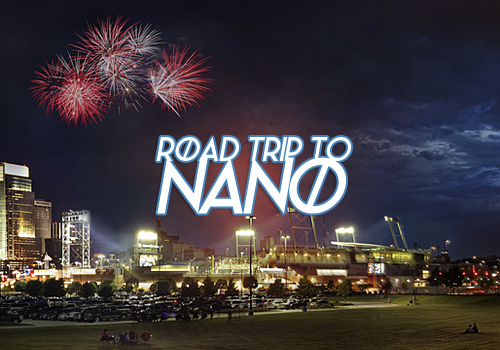
NaNoWriMo is an international event, and the stories being written every year reflect our hundreds of participating regions. We’re taking a Road Trip to NaNo to hear from our amazing volunteers and writers all around the world. Today, Chris and Cara, our Municipal Liaisons in the USA :: Nebraska :: Omaha region talk organization and setting:
Two things travelers stop by Omaha, Nebraska for are the the Henry Doorly Zoo and the College World Series. But how do these apply to NaNoWriMo?
Cara:
When I walk through the exhibits of the Henry Doorly Zoo, it’s easy to forget how much goes into creating a place like this. When I descend into my favorite exhibit, the Creatures of the Night, where you can experience caves of bats and a perfectly replicated swamp, I always admire the creativity and skill it took to construct this space. Not only is the environment wonderful, but it is also the perfect habitat for the animals that live there…
Your story is like those habitats. Often, world-building is lost in the plotting, but like the zoo, you must build your world to suit your story. Mapping out the lay of the land can help hugely in terms of plotting events, and even developing characters.
Think about the world your characters live in. Where do they come from? Where will they go? How are people from here different from there? How will they interact? Where do these places merge and how?
What I like to do when a story’s world is huge or complex is draw out maps. They don’t have to be beautiful, but putting down on paper how the world looks can help build the flow of the plot, figure out odd things like travel time, and generally remind you of the feel of your world.
More often than not, we don’t have time during NaNo to stop and address world-building issues. I encourage everyone to take some time and consider the habitat your story will live and grow in. Imagine where your characters will be and how they get there, then create a visual representation of that journey. Draw what their homes look like. Map, design, create, and, above all, have fun!
Chris:
You might wonder what inspiration I find in the College World Series. Well, it’s pretty simple, really: The World Series teaches you about planning, organization and adapting to adversity. These three things go hand in hand with any major endeavor, including NaNoWriMo.
To get to the World Series, you need to have a plan, and execute it well. To get a novel done, you also need a plan, even if it’s as simple as finding the time to wing it, or as complicated as a full-on outline with pages of character notes.
Still, without organization, you aren’t going to get anywhere, no matter the plan. If you aren’t organized, you are going to play sloppily. You are going to misplace where you saved your novel, forget where you left off, or forget where you intended to go. You have to be organized to get anything big accomplished, especially a novel.
Finally, you need to be able to adapt. Maybe the pitcher is a lefty, and you didn’t expect that. Or maybe one of your characters in your novel decides to kill another unexpectedly. You have to be able to adapt to changes, or you are going to run into writer’s block as you fight against what your subconscious is telling you.
This is what this non-sports fan takes away from the College World Series. I hope you can dig deep as well and hone your planning, organization and adaptability.

Cara Lee was born in Tennessee, but soon moved to Texas to have a fairly happy and uneventful childhood. At the age of ten, she moved to Omaha, NE, where life has been equally uneventful. She currently survives by working as a Shift Lead in a well-known pharmacy but would really be much happier sitting in a room typing on her computer all day. If you happen to meet her, don’t be surprised if she appears to be half asleep. Due to insomnia, she probably is.

Chris attended college at the University of Nebraska at Omaha for many years while he studied Computer Science and worked as a programmer. He married Nichola in 1992, and in 1995 and 1999 had two children, Valerie and Alex. He has over the years been writing novels during NaNoWriMo, most of which he would not share with even his worst enemies. He has risen to a leadership role in his NaNoWriMo group, helping with instruction as well as setting up write-ins year-round.
Top photo by Flickr user Chris Smith.
October 22, 2014
Road Trip to NaNo: Finding Your Creative Energy Generator
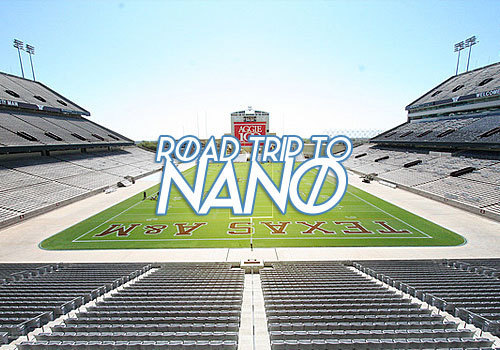
NaNoWriMo is an international event, and the stories being written every year reflect our hundreds of participating regions. We’re taking a Road Trip to NaNo to hear from our amazing volunteers and writers all around the world. Today, Summer, one of our Municipal Liaisons in the USA :: Texas :: Bryan-College Station region shares her secret for creating writing synergy:
Usually if I tell someone I’m from Bryan, Texas, the reaction flips between “Huh?” and “Where?” Switch it up to College Station, and some might go “Oh yeah, Texas A&M”, especially here in Texas where football is king and cities are known by their teams. In reality, the two are often mentioned together as Bryan-College Station, because they pretty much always have been. If you look at the cities on a map, their borders blend seamlessly into each other. You can literally drive down any number of roads and poof: you’ve flipped cities without even knowing it!
Historically, while the two towns often have a good-natured rivalry, they have continued to grow together, uplifting and supporting one another. I often liken our twin cities to a pair of fraternal twins: sure, they may trash talk each other now and then, but they always stand together in the face of adversity—two as one. As our police and fire departments note, ours is a community without borders.
This spirit of helping, of connectivity, of oneness regardless of our differences is something that carries through to the people who live here…
I’ve seen how that community bond affects the atmosphere of our in-person NaNoWriMo events and the wonderful effect it can have on participants. At every event you’ll see our participants helping each other, regardless of which city they come from, and regardless of their religious beliefs, race, economic status, gender, sexual orientation, political views, or NaNo “Rebel” status.
None of that matters when we get together, only that we all love to write and are in this thing together! Whether someone needs ideas, time to vent, or some encouragement, it’s available. And just like our twin cities, we welcome newcomers into the fold as if they were all old friends!
Even better, when the writing begins, there is this synergy that fills the room. It’s as if we turn into a giant creative energy generator! Almost everyone that comes to our write-ins leaves having churned out more words than they usually do on their own because of that awesome energy generated from being joined in a singular purpose. Our region enjoys an above average winning percentile, and I think it is in large part to the emotional and mental boosts our folks get from those in-person events.
Let me give you one example of the awesomeness of our Wrimo community: our final write-in is a seven-and-a-half-hour-long event to help folks cross the finish line. We’ve literally had years where half the people who came had already won. But they came out to help cheer the rest on and feed the energy machine. For seven and a half hours!! Talk about supporting your fellow writers!
Now, I have a challenge for you. If you’ve never gone to an in-person event, head to your regional forums, find the schedule, and plan to go to the next event. Most regions have events starting in October for planning, socializing, and of course awesome Kick Off Parties! If your region doesn’t have a ML, take the initiative and post in the forums to lead your own events.
Do you already go to in-person events (as either an ML or participant)? Continue to do your part in fostering that awesome NaNo community feeling: making new folks feel welcome, encouraging the discouraged, and cheering your fellow writers on!
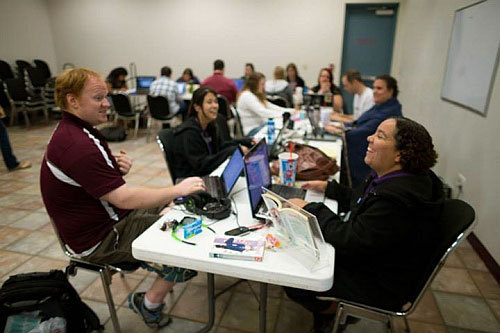

Summer is a southern girl at heart. A Wrimo since 2006, she broke from her introverted ways to become the Bryan-College Station ML in 2010. In the real world she’s a web developer by trade, mom to three fur babies, and biggest fan of her amazingly patient and supportive sweetie. She also reads too much manga, plays way too many video games, and loves Icees and Hello Kitty.
Top photo by Flickr user eschipul.
October 21, 2014
Road Trip to NaNo: Write Without "What Ifs"

NaNoWriMo is an international event, and the stories being written every year reflect our hundreds of participating regions. We’re taking a Road Trip to NaNo to hear from our amazing volunteers and writers all around the world. Today, Fox, one of our Municipal Liaisons in the USA :: Pennsylvania:: Pittsburgh region shares a little something about resilience:
When you’re born a Pittsburgher and move to another part of the country, you have to answer a lot of questions. Do they really close schools for Steelers Super Bowl victory parades? (Yes.) Is it true you put French fries on everything? (You bet we do!) Even salads? (Yes—just trust me on this one and thank me later.) What are those weird trolleys that go up the mountain? (They’re inclines.) Isn’t it just a big smoky mess from all the mills? (Umm… no. That was so a million years ago.)
Because despite the fact that we’re the reigning Most Livable City champs, we’re still known as the Steel City. And to many people, that means we’re still the industrial steel mill giant that made headlines not only for our revolutionary product, but for the deplorable environmental conditions.What are we actually?
We’re a little-big city with a lot of history and even more heart. And while we Yinzers (yes, that’s a scientific term for those of us who bleed black and gold) have pride in a lot of different aspects of our hometown, the one theme that carries through is Pittsburgh’s resilience. Through the decades, we’ve had to reinvent ourselves over and over.
We built our city on the mills, and when they shut down, we found a way to persevere. We cleaned up our city and became a leader in health care, technology, and the arts. We may hold onto silly traditions like using folding chairs to reserve parking spaces on snowy days, but we also have a thriving cultural district and a great art scene. Those rivers that were so dirty during the industrial era that nothing could live in them? They’re home to our annual 4th of July Regatta boat races and full of enough fish that we hosted the Bassmaster Classic in 2005.
So how can you carry the spirit of the ‘Burgh into your novel? Bring your heart and refuse to quit. Any time the writing knocks you down, get right back up and go harder. Turn a failure into a stepping stone and come back even stronger.
Don’t fret if the plot you outlined in October gets away from you. Say you’re a week into the month and your supporting character is pushing your main out of focus—fine. See what that supporting character can bring to the mix. Maybe it’ll turn out to be a mistake (the Steelers once tried to have cheerleaders; these things happen), but you can learn from it and come out wiser on the other end.
So as you think about your upcoming novel on your drive home (whether or not you’ve got to cross three rivers and go through a tunnel to get there), forget the worrisome ‘what ifs’.
If your original idea doesn’t pan out, trust in your own resilience to pull you through. Remember that a long morning of writer’s block won’t keep you from a 5,000-word sprint late that night. Because, my fellow writer, you’re just as resilient as our fine City of Steel. Whatever knocks you down in your writing journey won’t keep you there. Even if you take a step back first, you’ll dust yourself off and come back stronger than before. (Especially if you follow my tip about the fries on your salad.)
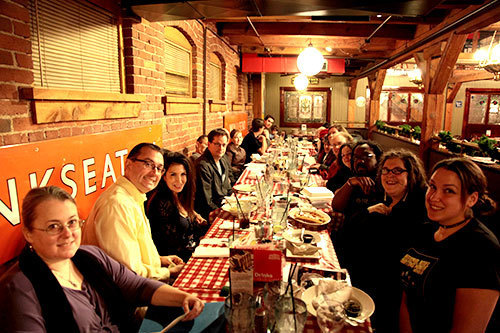

Fox has been WriMo-ing since 2002 (the dark ages when we had to IM each other at 3 in the morning on AOL Instant Messenger to check on word counts) and MLing the Pittsburgh region since 2008. She writes primarily paranormal YA, always makes mixtapes for her characters, and is the absolute worst at titles.
Top photo of Pittsburgh Children’s Museum by Flickr user PhotoMatt28.
October 20, 2014
Road Trip to NaNo: A Guide to Finding and Preserving Writing Inspiration
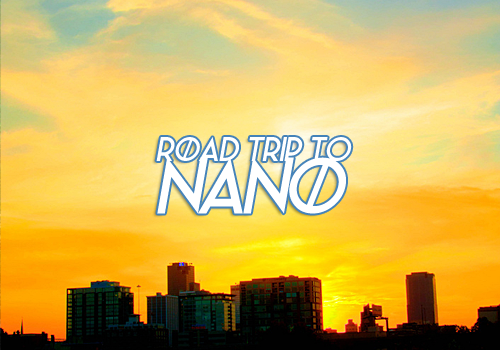
NaNoWriMo is an international event, and the stories being written every year reflect our hundreds of participating regions. We’re taking a Road Trip to NaNo to hear from our amazing volunteers and writers all around the world. Today, Megan and Kortney, our Municipal Liaison in the USA :: Arkansas :: Hot Springs/Little Rock region shares where to find inspiration… and how to sustain it:
Megan: If you’re not from the area, you probably don’t realize that Arkansas is a beautiful state. We may not have big cities teeming with skyscrapers, but we make up for that with natural wonder. We have waterfalls, caves dripping with stalactites, and large stretches of deep, green valleys contrasted with tree-covered mountains. Even if you live in the capital, Little Rock, you can drive about thirty minutes in any direction and find yourself lost in nature.
Growing up in Arkansas, I lived in a town that was as rural as you can get. I had thick forests on all sides of my house. Deer and bears would wander onto the lawn from time to time. I had to watch out for snakes hiding in high grass or even slipping into the house. Everyday I was surrounded by natural wonder. So what does living in a place like that do for the imagination of a child?
In my mind, I didn’t just live beside the woods—I lived beside a magical forest that hid dragons. There weren’t just squirrels in the trees, but goblins.
Inspiration can come from anywhere if you know how to look for it. As an adult, I live in the city in a house that is about four feet away from my neighbor’s house. I still find inspiration here: I can sit in my small backyard and listen to the sounds of children playing, or dogs barking at cars. Suddenly, I can see a story in my head—children lost in the post-apocalyptic remains of some alien planet with a pack of hyper-intelligent canines leading them to safety. (Well, maybe not that story, but you get the idea.)
Nature is inspiring—there are millions of stories to be found in it—but you don’t have to live in a writer’s retreat away from civilization to be inspired. Find inspiration in your surroundings: listen to the noises of traffic, smell the cooking in restaurants, and take in all the colors of the sky. If you take the time, you’ll find a story.
Kortney: As Megan mentioned, our state is full of natural wonders and wide, open spaces—a perfect writing environment. But what happens when you just aren’t feeling the whole writing thing one day?
Days like this are bound to pop up during the month of November. The secret is not only expecting these days but knowing how to breeze through them without missing a beat or falling behind on your word count. But how?
Outlining. I use this term loosely. Whether your outline contains only a list of your characters and locations, or the details of every nook and cranny of your story, having a roadmap will save you from the abyss of not knowing what to write next.
Find your tribe. Part of the magic of NaNoWriMo is knowing that you are part of a global writing community that are all taking the same challenge of churning out 50,000 words in 30 days. Find people locally and elsewhere (via the forums) that can cheer you on, and help you get back on track with that amazing story you’ve got up your sleeves.
Get back to the basics. What is it that compelled you to write the story you’re writing? Was it the quirky characters? The fantastic world your characters live in? The story’s message or tone that you have to get out to the world? Take notice of whatever it is that gets you excited about what you’re working on—it just might be the oasis in the desert you need.

Kortney Hinton is an urban fantasy and science fiction writer in Little Rock, Arkansas. This is her 8th year participating in NaNoWriMo and her 4th year being ML for the Little Rock/Hot Springs region. She’s pumped and motivated to get started this NaNo season.

Megan Neumann is a speculative fiction writer living in Little Rock, Arkansas. This is her seventh NaNoWriMo and her first year as co-ML in the Little Rock/Hot Springs region. You can find her short fiction online at such publications as Luna Station Quarterly, Perihelion Science Fiction, and SQ Mag.
Top photo by Flickr user Tuaussi.
October 18, 2014
We Need Diverse Books: A Guide to Spotting and Growing Past Stereotypes
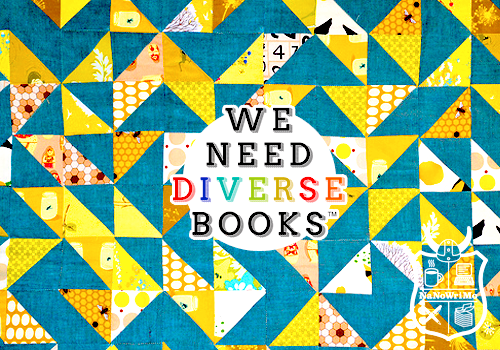
Throughout October, we’ll be partnering with We Need Diverse Books to bring you a series of blog posts full of helpful advice, tips, and suggestions for writing diversity convincingly and respectfully in your fiction—from people who know what they’re talking about. Today, Ellen Oh shares how to identify, then expand beyond stereotypes:
One of the most common mistakes I see when people try to write diversely is that they fall into the practice of writing a positive stereotype. After all, if it’s positive, it can’t be a stereotype, right?
Wrong.
A stereotype is a positive or negative set of beliefs about the characteristics of a group of people. Just because it is positive, doesn’t make it any less problematic.
Why?
Because a stereotype is a generalization, and a generalization can never come fully to life in your story, no matter how beautiful your words might be. Readers want to care for your characters. Talk to any fan of a well-loved book, and they can often rattle off the detailed physical characteristics, and tragic backstory of their favorite character.
As an author, this is what you want. You want your readers to fall in love with your characters. But how can they if even the author doesn’t believe in them? Because a stereotype is a dead giveaway that:
You don’t care enough about a character to invest the time to learn about them beyond superficial generalities, and
They are not real to you.
And if you don’t care, why should your reader?
Just because you know actual people who may fit a certain stereotype doesn’t justify writing a character whose defining characteristic is that stereotype. Most people cannot be summed up into a neat package. They are reasonable, and emotional, and creative, and practical and silly and wise and impulsive and so very complex. Just like you are. When you approach diversity in your writing, a good rule of thumb is this—how well do you know your characters? The more fleshed out your character is, the less likely you will fall into the fatal trap of stereotypes.
But what if you need your Asian protagonist to be really good at math because it is pivotal to your plot? Or your black character is the star athlete? It all comes down to execution. And that depends on how well you’ve researched your material. How much you care to get it all right.
In Gene Luen Yang’s excellent speech at the National Book Festival he said:
“We have to allow ourselves the freedom to make mistakes, including cultural mistakes, in our first drafts. I believe it’s okay to get cultural details wrong in your first draft. It’s okay if stereotypes emerge. It just means that your experience is limited, that you’re human. Just make sure you iron them out before the final draft. Make sure you do your homework. Make sure your early readers include people who are a part of the culture you’re writing about. Make sure your editor has the insider knowledge to help you out. If they don’t, consider hiring a freelance editor who does.”
That’s how far you should go to make sure that you are doing it right. And this applies to all writers, no matter their background, who want to write about an experience that is different from their own. Just because you are from a marginalized background yourself, doesn’t give you a pass from these rules. If anything, you should be more aware of the importance of accurate representation.
And so I address all writers, everywhere: When you’re done with your manuscript, ask yourself, “Have I done my characters justice?” Do they read as fully fleshed out, complex characters?” Because only then will you have done your part in ridding the world of stereotypes in favor of truth. And your readers will thank you for it.

Originally from NYC, Ellen Oh is Co-founder and President of We Need Diverse Books, and adjunct college instructor, with an insatiable curiosity for ancient Asian history. She also loves martial arts films, K-pop, K-dramas, cooking shows, and is a rabid fan of The Last Airbender and the Legend of Korra series. She is the author of the YA fantasy trilogy, The Prophecy Series. Ellen lives in Bethesda, Maryland with her husband and three daughters and has yet to satisfy her quest for a decent bagel.

We Need Diverse Books (WNDB) is a grassroots nonprofit organization created to address the lack of diverse, non-majority narratives in children’s literature. WNDB is committed to the ideal that embracing diversity will lead to acceptance, empathy, and ultimately equality.
In October, the group will be launching its inaugural Indiegogo campaign to support its future initiatives, including a Diversity in the Classroom program, diverse author grants and awards, and the first ever Diversity Festival in 2016. Volunteer & sign up for its mailing list at diversebooks.org, or follow WNDB on Twitter, Tumblr, Facebook, and Instagram!
October 17, 2014
Road Trip to NaNo: Flock with Writers of Different Feathers
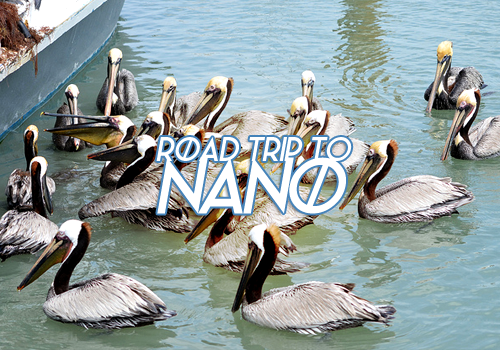
NaNoWriMo is an international event, and the stories being written every year reflect our hundreds of participating regions. We’re taking a Road Trip to NaNo to hear from our amazing volunteers and writers all around the world. Today, Gloria, our Municipal Liaison in the USA :: Texas :: Corpus Christi region shares why it’s important to flock with writers:
Corpus Christi, Texas, is the “birdiest” city in the U.S. I know, it’s a very strange claim to fame, isn’t it? My hometown has more individual species of birds than any other city in the nation. Maybe it’s the warm waters along the Texas gulf coast that draw them here. Every autumn, the power lines, branches, and roof tops fill wing to wing with black birds.
I’ve lived here my whole life and I’ve never learned what species these black birds are. I just know that I’ve always loved their raucous din of chirping in the shopping centers. The seagulls, sandpipers, and hawks that stay here year round, soaring across rainbow sherbet sunsets to tease slow-draw photographers, will play host to all manner of hummingbirds and cardinals from up north.
Truthfully, I don’t know if I’ve got the specifics right. I’ve never learned which birds are the ones who migrate here in the autumn. I don’t know if they get here in November or December. This is a great shame to me as I consider myself an obsessive researcher…
Last Friday was our Downtown Artwalk and the folklore of our region’s Hispanic heritage was the theme. I was handing out flyers for NaNoWriMo as I strolled with my friends from the Texas A&M campus. At the age of 34, I had decided to leave my 10-year IT career for a Bachelor’s degree in English with the dream of being an editor.
I felt like a bit of an odd bird myself, dancing around to every band chirping their tunes on the corner. Several tents displayed gorgeous tableaus of moonlight on our local waters. Others had fanart from sci-fi shows, or depictions of Día de Los Muertos. Holistic healers sold their wares as tattooed rebels pushed baby strollers past the bluegrass band. The clash of voices was glorious to my ears. We packed ourselves wing to wing with every color of feather.
We were all there for the same reason. We all had a story to tell and our very own way of telling it. Corpus Christi is an unusual nexus where a person can run into that stranger they met on a trip to New Zealand, or that childhood friend they’d lost touch with. People come here. They just do. Maybe it’s the warm waters. Maybe it’s the university, or the port but they all come ready to tell their stories. What a great shame it is for me, an obsessive researcher and aspiring writer, that I’ve never learned their names and types, or heard every tale to be told right here in my own home.
This year, pay attention to the different voices around you. Challenge people to tell their stories; let them know that you want to hear what they have to say. Invite them to your NaNoWriMo write-ins, then listen closely through all the singing of voices and ideas that make up your region.
It wasn’t until I became Corpus Christi’s NaNoWriMo municipal liaison that I began to listen to these distinct voices. I read journal entries and poems, scripts and manuscripts from every genre. Romance and science fiction writers made a raucous din with western and mystery writers around our meeting table. Chirp chirp chirp! And I the gawky sandpiper have the honor to host my kin every year when the NaNo season draws us to the warm waters of the Gulf Coast.

Gloria was born and raised in Corpus Christi, Texas, the youngest of seven siblings. She returned to school to receive her degree in English after a 10-year IT career, and founded a local writing network, the South Texas Scribes. Her passion is coaxing the underrepresented language talents that are rife in the lives and experiences of the coastal bend.
Top photo by Flickr user TheBrit_2.
October 16, 2014
Road Trip to NaNo: Writing Is an Adventure Into the Unknown
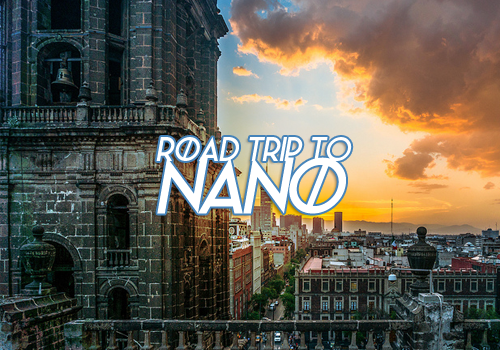
NaNoWriMo is an international event, and the stories being written every year reflect our hundreds of participating regions. We’re taking a Road Trip to NaNo to hear from our amazing volunteers and writers all around the world. Today, Andy, our Municipal Liaison in the Mexico :: South region challenges you to venture into the unknown:
Welcome to Mexico City! As one of the Big Cities of the world, we share many similarities with other, perhaps more fashionable destinations, like New York, London or Tokyo. But what we lack in popularity, we make up for with this: there is always something in Mexico City to pique your interest.
Music? I’ve heard orchestras and rappers in opera halls. Plastic arts? We have more museums than any other city in the world. There are dancing halls dedicated exclusively to Charleston and swing, themed bars (like the one based around the Cthulhu mythos), book signings, board game tournaments, farmers’ markets and pretty much everything in between.
How can I manage to know so much about this city? I don’t. Mexico City is, if anything, a place to get rid of the fear of the unknown.
There are unknowns in the places you’ve never visited out of boredom, distance, or even fear. The dark alley can certainly be dangerous, but if you’re cautious and in good company, you might just find a delicious café in the shadows.
There are also unknowns in disguise. There’s a newspaper office close to my house, on a block I’d never bothered visiting at night. It turns out there’s this really cheap, really good taco place right next door, open only from 2 AM to 8 AM to service the late-night journalists.
There are unknowns hidden by time. Some places get better with age and others… are not so lucky. These unknowns are like Schrödinger’s cat: the only way to know whether they’ve become better or worse is to go and have a look.
Trying something new in your writing is always scary, but it doesn’t have to be an all-or-nothing experience. Think of it the way you might explore the City: the first time, you may only go one block toward that new restaurant, then call it a day. It’s fine as long as you come back the next day. Then you actually cross the street, go through the door. Then you order something. Then the magic happens.
Living in a Big City and not experiencing it seems like a waste of time to me. Maybe you won’t like everything, maybe you’ll step out of your comfort zone only to find that yes, you are really uncomfortable. Even so, you will grow in the process. The adventure of the unknown might take you to your new favorite place, a new niche made just for you. And if you don’t find a new place, the experience itself will teach you to appreciate the places you already know.
Try a new genre, hang around in a different NaNo group, emulate your best friend’s favorite author. The new experience is there, yours for the taking. You have to be brave enough to take it. Go ahead, take a walk, explore. You’ll come back a better writer.


Andy is an Environmental Engineer by day, and a Wikipedian/writer by night. He’s starting his Masters in Philosophy of Sciences this December because sleep is overrated. He is weak to cookies.
Top photo by Flickr user Game of light.
30 Covers, 30 Days: An Introduction
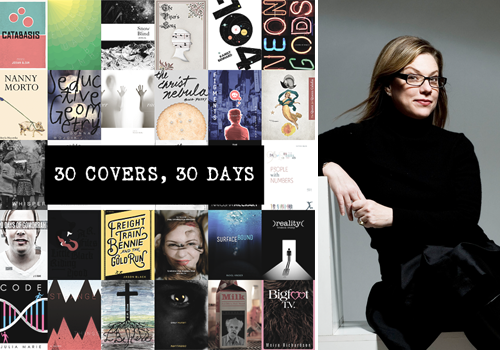
Attention, Wrimos! Ye Olde 30 Covers, 30 Days event is commencing as we speak! In fact, update: it has already commenced. It’s happening. You are a part of it now. Surprise.
What is 30 Covers, 30 Days?
Thirty lucky Wrimos will be selected to receive a shiny, unique cover for their 2014 NaNo-novel, designed in just 24 hours by one of the talented professional graphic designers that our amazing 30C30D coordinator, Debbie MIllman, has recruited this year.
Then, every day in November, one of these covers will be posted for all the world to see here on the blog. You can take a gander at some of our past covers here.
Tell me more about Debbie Millman. She sounds cool.
Very astute. She is cool! Debbie Millman is a writer, educator, artist, brand consultant and host of the radio show Design Matters. She has been president of Sterling Brands for the last twenty years, President Emeritus of the American Institute of Graphic Arts, and has run 30 Covers, 30 Days for the last two years.
She’s rad. You can follow her on Twitter here.
How do I get involved?
Nominate your own novel, or the novel of a fellow Wrimo for a cover here. Authors are chosen from the pool of nominations we receive, so it can never hurt to try your luck.
This year, the Young Writers Program will be sharing the nomination form with the NaNo participants. As you sally forth, please keep in mind the following things:
You do not have to share your real name on the nomination form. You are always free to offer a pen name.
Read over your form carefully before you submit it to make sure all the information appears the way that you want it to! You cannot edit your information after submitting it.
Want to design a book cover for a Wrimo? Can’t take the suspense of waiting to see if your novel will be receiving a cover from Debbie’s team? We highly suggest checking out the NaNo Artisans forum!
I’ve nominated a novel! Now what?
Give yourself a high five for us! We will make sure to let you know if your synopsis is sent to a graphic designer, and then again if it’s picked by that designer to get a cover!
So sit tight, novelists. You’ll be hearing from us soon. We’ll have our people call your people; it will all be very official.
Good luck!
— Gwen
October 15, 2014
Road Trip to NaNo: The Right Way to Plan for Your Novel
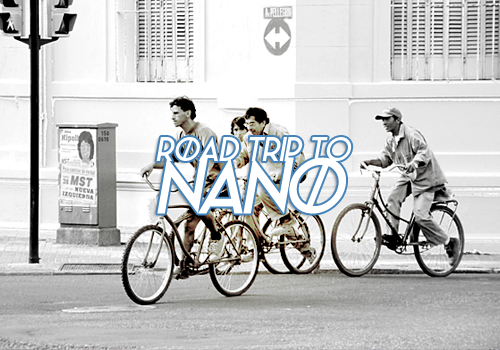
NaNoWriMo is an international event, and the stories being written every year reflect our hundreds of participating regions. We’re taking a Road Trip to NaNo to hear from our amazing volunteers and writers all around the world. Today, Alejandro, our Municipal Liaison in the Central & South America :: Argentina region debates whether you should plan or not:
Every year for the last five years or so, I’ve been getting an itch around October. I’d call it NaNoItch, but that sounds like a Russian illness, and it’ll probably get printed on a T-shirt or something… I digress.
That itch gets scratched (a lot!) during November. But as I get older (and closer to marriage and fatherhood), finding the time to do NaNoWriMo gets more difficult. You know, it would be so easy to cheat and say I wrote that mammoth fantasy novel in just one month. But we don’t want to do that, right? The right way to cheat is to do all your planning months before. Piece of cake, right?
But I struggle with my own advice because of cultural reasons. As someone from Argentina, a country that has gone through its share of social/economic/pretty-much-every-kind-of upheaval, we as a culture are so used to ‘making do’ and being uncannily creative with what little resources we have, that at least for me, when NaNoTime (that’s even better for a T-shirt!) comes around, I don’t get nervous. Zero. Nada.
In our country, you’re born with a PhD in “improvising at the last minute because something happened”. We invented the heart-bypass surgery, fingerprint IDs, the first helicopter, and the modern ballpoint pen. I think we can manage a little novel-writing. But that over-confidence works against our planning abilities, making us procrastinate a lot.
So that’s why I’m more of a ‘seat-of-my-pants’ writer than a Post-it hoarding, notebook-filling ‘planner’. Sometimes it works wonderfully; sometimes it makes for a first draft that makes you want to invest an equal amount of time in building a time machine so you can go back and tell yourself you’re screwing it up. But in some cases (for a big, complex, or plot-dependent novel) you need to have a bird’s-eye view, and plot everything carefully, world-building like a nine-year-old hooked on Minecraft and Mountain Dew.
What I’ve learnt is that there’s no right way to do things except what works. Do it, test it, review it. Be honest with yourself. Before NaNoWriMo begins, find the spots in your novel where it would be best to be a planner, and the spots where it would be better left to wacky ol’ improvisation. There are scenes that will benefit greatly from some forethought, and some that are better left open so your mind can fill in the blanks. Try to hit a good proportion (70/30 at most) so there’s always room for unexpected plots to arise, which will make your novel much more alive.
Trust yourself, and then hope it all works out splendidly. If not… well, don’t blame me; you can join me in editing. Alejandro Gamen is an Argentinian writer who has written six novels, sold one, and set the rest free in the wild, hoping for some to be eaten by the elusive and legendary beast known as the Book Award. He writes in Spanish or English, according to his mood. He’s participated in NaNoWriMo since 2009, almost always winning fair and square.
Alejandro Gamen is an Argentinian writer who has written six novels, sold one, and set the rest free in the wild, hoping for some to be eaten by the elusive and legendary beast known as the Book Award. He writes in Spanish or English, according to his mood. He’s participated in NaNoWriMo since 2009, almost always winning fair and square.
October 14, 2014
Road Trip to NaNo: Writing Requires Committment Without Excuses
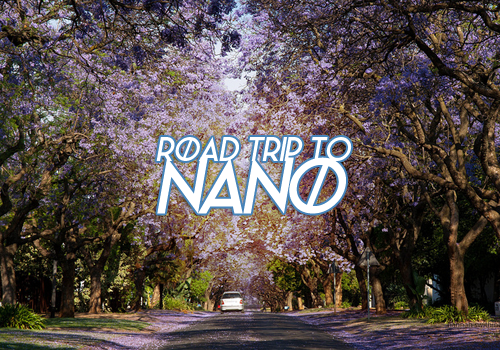
NaNoWriMo is an international event, and the stories being written every year reflect our hundreds of participating regions. We’re taking a Road Trip to NaNo to hear from our amazing volunteers and writers all around the world. Today, Alyssa, one of our Municipal Liaisons in the South Africa :: Pretoria region shares why writing requires committment:
Come closer to the heart and rhythm of Africa. You are welcome here for we are a rainbow nation brought together by a dream of freedom and equality for all. Being at the southernmost tip of Africa, we carry the continent on our shoulders and we do not shrug under its weight. This is South Africa and you are welcome. Here you will find ferocious writers and dancing women. You will find humour and comradeship. This is the spirit of not just my region, but of my country as well…
It is NaNoWriMo that drives us to reconnect with our fellow writers year in and year out. This group has grown from handful of people to a storm I need to rent a venue for. And they do not simply close the door on each other when November ends. Instead they strive to connect throughout the year, supporting and encouraging each other in their writing. NaNoWriMo might be doable on your own, but it is most memorable if you do it with others.
We can all write any day of the year, but it is only in November that we can do it with the support of a community both nationwide and international (a wave to Brantford-Norfolk Canada, because you were simply the best word war buddies ever).
That support is needed. I’ve had the privilege of meeting a lot of writers in my time as ML and even the pleasure of seeing some of them publish. A lesson I have learned and keep on wishing to teach my writers is the following:
Write.
It seems silly for me to say so given the company, but I’ll say it again.
Write. Just write.
I’ve met many people who want to be writers, and come across even more excuses for why they don’t write. They talk about a lack of inspiration, about a lack of time, energy and even a lack of planning. The excuses for their lack of productivity pile up into a mountain that seems impossible to climb.
Sometimes it’s because they try and do it all at once and fail horribly. You see, writing isn’t a sprint. NaNoWriMo is, yes. It’s a mad month of dashing forward and achieving the impossible. But creating a lifestyle of writing should be a marathon. It should be a long-term commitment that begins this November.
Let go of your excuses, set aside some time as a permanent appointment in your calendar, roll up your sleeves, and write. Don’t stop because you think you’re not good enough, because you are and will get even better with practice.
Eat. Write. Sleep. Write. Live. Write.
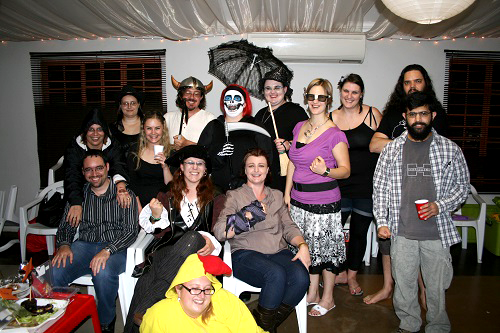
Alyssa has something of a reputation for never quite letting a NaNoWriMo slide without a word war. This is her fifth consecutive year as ML for Pretoria, South Africa. Writing has always been a necessary passion, a tool with which to enrich herself and others. A proud writer of novel-length fanfiction, and occasionally crowning herself Supreme Ruler of the Universe, she’s not as interesting in real life as she is on paper.
Top photo by Flickr user Swiv.
Chris Baty's Blog
- Chris Baty's profile
- 63 followers




